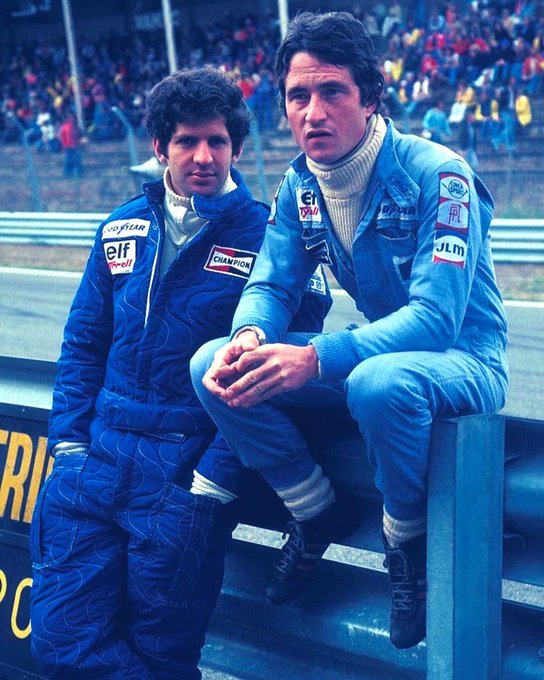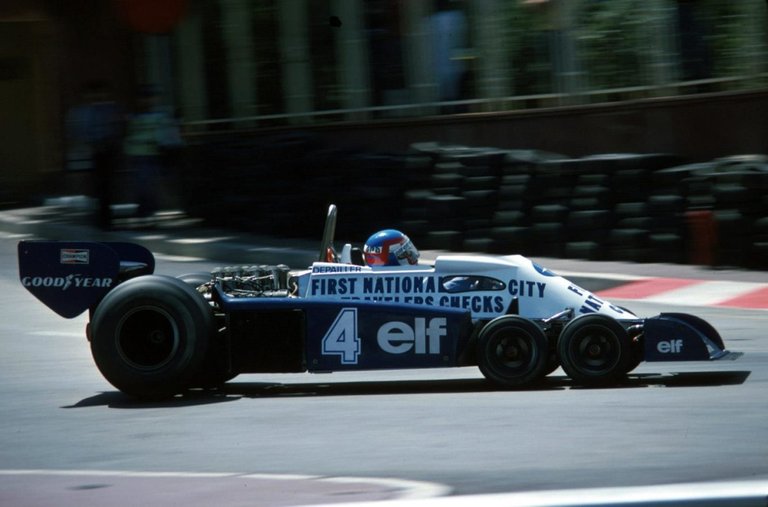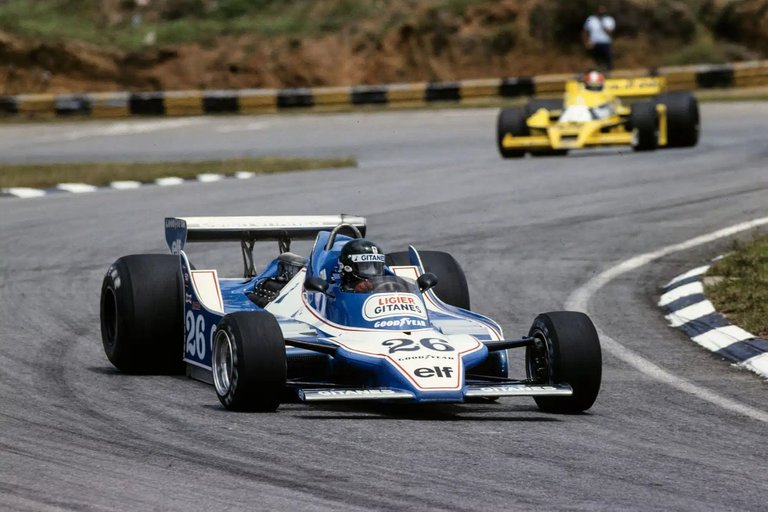El futuro es para otros (SPA-ENG)

Se dice que esa frase "El futuro es para otros", era recurrentemente utilizada por Patrick Depailler, principalmente cuando su contador le reclamaba poner en orden sus cuentas.
Esa frase resumía perfectamente sus sentimientos y motivaciones, era la representación exacta de su vida como corredor de autos de fórmula 1 y también en el ámbito privado. Patrick era adicto a la adrenalina y vivía con tanta intensidad que parecía extralimitarse en cada situación.
En el año 1976 tuvo la suerte de poder correr con ese automóvil que hizo estremecer todos los talleres y tableros de dibujo de las diferentes escuderías que competían en el gran circo de la F1, me refiero al Tyrrell P34, el auto de 6 ruedas que el genio de Derek Gardner ideó y construyo con la simple idea de reducir la fricción o lo que es lo mismo la resistencia aerodinámica del tren delantero con el uso de neumáticos más pequeños, para ello ideó el auto de 6 ruedas, las dos traseras del tamaño acostumbrado y 4 adelante en tándem de 2 por lado de tan solo 10". El auto tuvo éxito y hasta se dio el lujo de hacer el 1-2 en el gran premio de Suecia de ese año, tan solo 4 carreras le costó llegar al primer triunfo, Jody Scheckter ganó y Depailler terminó segundo. Sin embargo, había serios problemas de desgaste y frenos y para peor, Goodyear no tuvo un compromiso fuerte en la fabricación, era el único equipo que requería ese tamaño de neumáticos y ellos debían surtir a toda la parrilla. Se puede decir que el fracaso del auto de 6 ruedas se debió al fabricante de neumáticos.

Pero basta del Tyrrell P34, mi idea es hablar de Depailler.
James Hunt, el simpático y carismático campeón del año 1976 definió a Patrick como una persona que buscaba el riesgo en todo lo que hacía, y hasta más lejos en sus declaraciones: mencionó no tener dudas que el francés tenía deseos de morir.
Varios hechos puntuales parecen darle la completa razón a Hunt, Depailler debutó en 1972 con Tyrrell, pero un accidente de motocross lo alejó por un tiempo, regresó a la escudería recién en 1974. Como dije anteriormente, en 1976 condujo el P34 y con ese vehículo extraño, aunque sorprendente, se subió 5 veces al podio y terminó 4to. en el campeonato. En 1977 retrocedió un poco al volver la escudería a utilizar vehículos convencionales y en 1978 ganó su primera carrera en la categoría, nada menos que en Mónaco, aunque su vehículo tuvo altibajos y solo le permitió terminar ese año en 5ta. posición el torneo.

1979 parecía ser mejor, firmó con la escudería Ligier y obtuvo su segundo y último triunfo en España, pero otra vez un accidente, esta vez con un ala delta, le provocó la fractura de ambas piernas y su alejamiento de las pistas; pasó por varias operaciones y hasta se habló de amputación, pero su espíritu y su fortaleza física le dieron una última oportunidad. El francés de los Gitanes y el gusto por el vino fino de Burdeos se había dado el lujo de correr en una escudería totalmente francesa, pero dilapidó esa posibilidad gracias a esa necesidad de más peligro.
En 1980 regresó, pero esta vez con un Alfa Romeo que estaba en una etapa experimental, corrió 8 carreras y no finalizó ninguna. El 1 de agosto de ese mismo año, en un entrenamiento privado con vistas al gran premio de Alemania, el arriesgado piloto perdió la vida en una curva al estrellarse contra los rieles de protección del circuito.
El hombre que vivía a máxima velocidad y solo disfrutaba el presente, terminó su vida de la manera en que seguramente había planeado, disfrutando del vértigo y la adrenalina.
The future is for others
It is said that this phrase was used repeatedly by Patrick Depailler, mainly when his accountant asked him to put his accounts in order.
That phrase perfectly summed up his feelings and motivations, it was the exact representation of his life as a Formula 1 car racer and in the private sphere. Patrick was addicted to adrenaline and lived so intensely that he seemed to overextend himself in every situation.
In 1976 he was lucky enough to be able to race with that car that shook all the workshops and drawing boards of the different teams that competed in the great circus of F1, I am referring to the Tyrrell P34, the 6-wheeled car that Derek Gardner's genius devised and built with the simple idea of reducing friction or what is the same, the aerodynamic resistance of the front axle with the use of smaller tires, for this he devised the car with 6 wheels, the two rear ones of the usual size and 4 forward in tandem of 2 per side of only 10". The car was successful and even had the luxury of doing 1-2 in the Swedish Grand Prix that year, it only took 4 races to reach the first triumph, Jody Scheckter won and Depailler finished second. However, there were serious problems with wear and brakes and to make matters worse, Goodyear did not have a strong commitment to manufacturing, it was the only team that required that size of tires and they had to supply everyone. The grill. It can be said that the failure of the 6-tired car was due to the tire manufacturer.
But enough about the Tyrrell P34, my idea is to talk about Depailler.
James Hunt, the charismatic champion of 1976, defined Patrick as a person who sought risk in everything he did, and even had the luxury of going further: he mentioned without a doubt that the Frenchman had the desire to die.
Several specific facts seem to prove Hunt completely right. Depailler debuted in 1972 with Tyrrell, but a motocross accident kept him away for a while. He returned to the team only in 1974. As I said before, in 1976 he drove the P34 and with that vehicle strange, although surprising, he was on the podium 5 times and finished 4th. in the championship. In 1977 he regressed a bit as the team returned to using more conventional vehicles and in 1978, he won his first race in the category, in Monaco no less, although his vehicle had ups and downs and only allowed him to finish that year in 5th. position.
1979 seemed to be better, he signed with the Ligier team and obtained his second and last victory in Spain, but again an accident, this time with a hang glider, caused him to fracture both legs and take him away from the slopes; He underwent several operations and there was even talk of amputation, but his spirit and physical strength gave him one last chance. The Frenchman from the Gitanes and the taste for fine Bordeaux wine had given himself the luxury of racing in a completely French team, but he squandered that possibility thanks to his need for more danger.
In 1980 he returned, but this time with an Alfa Romeo in an experimental stage, he ran 8 races and finished none. On August 1 of that same year, in private training with a view to the German Grand Prix, the risky driver lost his life in a curve when he crashed into the circuit's protection rails.
The man who lived at maximum speed and only enjoyed the present, ended his life the way he had surely planned, enjoying the vertigo and adrenaline.
Héctor Gugliermo
@hosgug
Saludos querido amigo, linda historia.
Bienvenido de regreso amigo!!
A ver cuando disfrutamos de sus historias.
Excelente trabajo mi estimado amigo @hosgug. Sus escritos enganchan a uno como lector. Mis felicitaciones
"El futuro es para otros", muy buena frase que deja mucho que pensar, el resumen maravilloso del corredor de F1 Patrick Depailler, es un hecho de determinación y pasión por lo que le gustaba hacer, no se dejó vencer a pesar por todo lo que pasó, es inspiración, de eso estoy segura, gracias por compartirlo amigo, fuerte abrazo 😘
Saludos.
Excelente aporte.
Patrick Depailler no era considerado un piloto imprudente, para entonces ese reconocimiento era para Gilles Villeneuve, pero sí tenía la obsesión de convertirse en el primer francés en alcanzar el título de campeón de Fórmula 1. Él llegó a brillar en la Fórmula 2, inclusive fue campeón de esa categoría en 1974, mientras también era piloto de Tyrrell en la Fórmula 1. Demostrar que era el mejor piloto galo de su generación le llevó a frustrarse porque iniciaba muy bien las temporadas, pero la fiabilidad y la suerte no le acompañaban y eso le llevó a presionarse aún más.
En el año de su trágica muerte, Depailler llegó a Alfa Romeo porque no tenía otra opción. Su accidente fuera de las pistas impidió a Ligier luchar por el título, por eso traen a Pironi y le dejan en libertad. Con Alfa no finalizó ninguno de los ocho grandes premios en los cuales participó, el 179 era un desastre, pero lo que más le dolía era observar a sus compatriotas y rivales: René Arnoux, Didier Pironi, Patrick Tambay, Jean-Pierre Jarier y Jean-Pierre Jabouille, a quienes había vencido con regularidad, en mejores escuderías y ganando carreras, todos salvo Jarier. Justamente en 1980 el equipo Renault asoma el potencial del motor turbo, con Jabouille y Arnoux, y apareció en la parrilla el debutante Alain Prost, quien comenzaba a mostrar destellos de grandeza con McLaren.
Todo aquel panorama precipitó su destino. De Patrick Depailler siempre se esperó mucho, inclusive contó con el padrinazgo de Jean-Pierre Beltoise, pero sin duda no tuvo suerte en la Fórmula 1, con todo y que se batió con grandes de la talla de Niki Lauda, Jackie Stewart, Mario Andretti y Emerson Fittipaldi.
También es muy recordada su frase: "Soy valiente, pero no estoy loco".